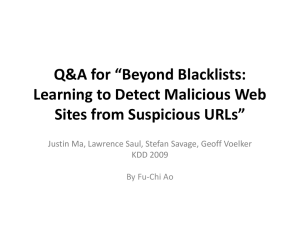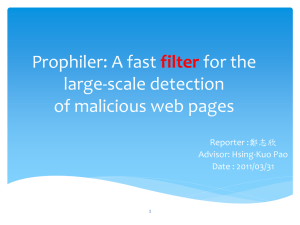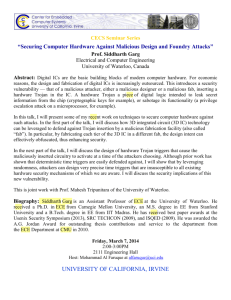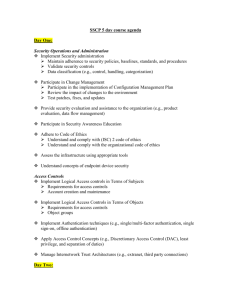ADAM: Automated Detection and Attribution of Malicious Webpages
advertisement
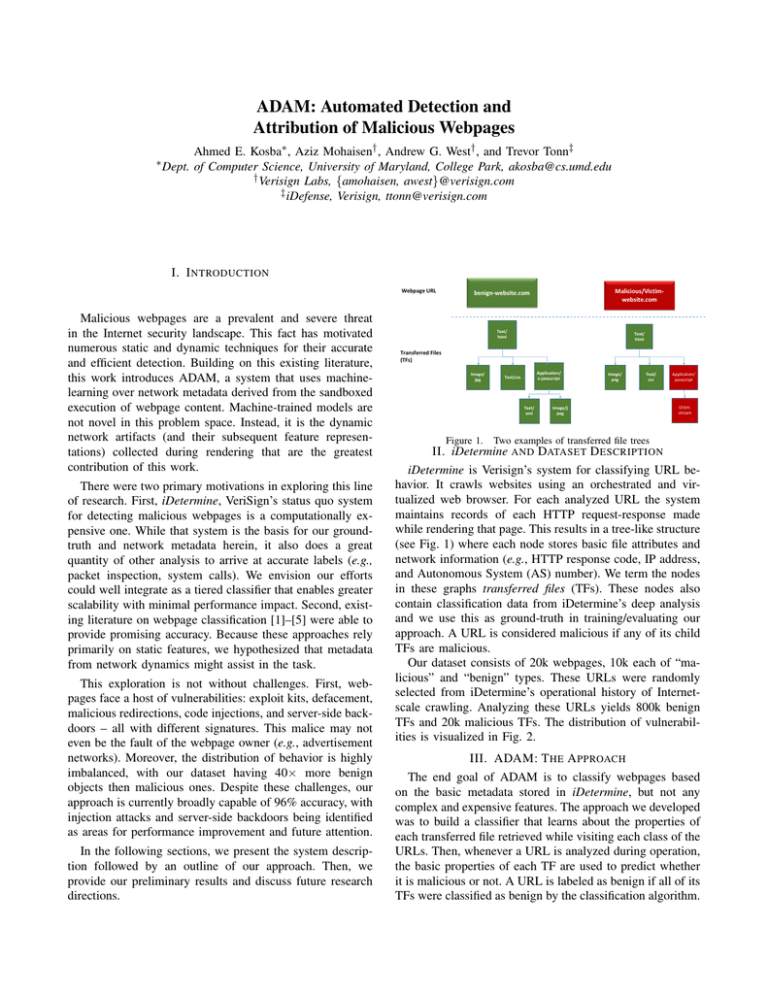
ADAM: Automated Detection and
Attribution of Malicious Webpages
∗ Dept.
Ahmed E. Kosba∗ , Aziz Mohaisen† , Andrew G. West† , and Trevor Tonn‡
of Computer Science, University of Maryland, College Park, akosba@cs.umd.edu
† Verisign Labs, {amohaisen, awest}@verisign.com
‡ iDefense, Verisign, ttonn@verisign.com
I. I NTRODUCTION
Webpage URL
Malicious webpages are a prevalent and severe threat
in the Internet security landscape. This fact has motivated
numerous static and dynamic techniques for their accurate
and efficient detection. Building on this existing literature,
this work introduces ADAM, a system that uses machinelearning over network metadata derived from the sandboxed
execution of webpage content. Machine-trained models are
not novel in this problem space. Instead, it is the dynamic
network artifacts (and their subsequent feature representations) collected during rendering that are the greatest
contribution of this work.
There were two primary motivations in exploring this line
of research. First, iDetermine, VeriSign’s status quo system
for detecting malicious webpages is a computationally expensive one. While that system is the basis for our groundtruth and network metadata herein, it also does a great
quantity of other analysis to arrive at accurate labels (e.g.,
packet inspection, system calls). We envision our efforts
could well integrate as a tiered classifier that enables greater
scalability with minimal performance impact. Second, existing literature on webpage classification [1]–[5] were able to
provide promising accuracy. Because these approaches rely
primarily on static features, we hypothesized that metadata
from network dynamics might assist in the task.
This exploration is not without challenges. First, webpages face a host of vulnerabilities: exploit kits, defacement,
malicious redirections, code injections, and server-side backdoors – all with different signatures. This malice may not
even be the fault of the webpage owner (e.g., advertisement
networks). Moreover, the distribution of behavior is highly
imbalanced, with our dataset having 40× more benign
objects then malicious ones. Despite these challenges, our
approach is currently broadly capable of 96% accuracy, with
injection attacks and server-side backdoors being identified
as areas for performance improvement and future attention.
In the following sections, we present the system description followed by an outline of our approach. Then, we
provide our preliminary results and discuss future research
directions.
benign-website.com
Malicious/Victimwebsite.com
Text/
html
Text/
html
Transferred Files
(TFs)
Image/
jpg
Application/
x-javascript
Text/css
Text/
xml
Figure 1.
Image/
png
Text/
css
Image/j
peg
Application/
javascript
Octetstream
Two examples of transferred file trees
II. iDetermine AND DATASET D ESCRIPTION
iDetermine is Verisign’s system for classifying URL behavior. It crawls websites using an orchestrated and virtualized web browser. For each analyzed URL the system
maintains records of each HTTP request-response made
while rendering that page. This results in a tree-like structure
(see Fig. 1) where each node stores basic file attributes and
network information (e.g., HTTP response code, IP address,
and Autonomous System (AS) number). We term the nodes
in these graphs transferred files (TFs). These nodes also
contain classification data from iDetermine’s deep analysis
and we use this as ground-truth in training/evaluating our
approach. A URL is considered malicious if any of its child
TFs are malicious.
Our dataset consists of 20k webpages, 10k each of “malicious” and “benign” types. These URLs were randomly
selected from iDetermine’s operational history of Internetscale crawling. Analyzing these URLs yields 800k benign
TFs and 20k malicious TFs. The distribution of vulnerabilities is visualized in Fig. 2.
III. ADAM: T HE A PPROACH
The end goal of ADAM is to classify webpages based
on the basic metadata stored in iDetermine, but not any
complex and expensive features. The approach we developed
was to build a classifier that learns about the properties of
each transferred file retrieved while visiting each class of the
URLs. Then, whenever a URL is analyzed during operation,
the basic properties of each TF are used to predict whether
it is malicious or not. A URL is labeled as benign if all of its
TFs were classified as benign by the classification algorithm.
Table I
E VALUATION RESULTS
NUMBER OF TFS PER MALICIOUSNESS TYPE
Acc.
0.965
0.930
Redirector, 1657
Exploit Kit, 5102
Exploit, 1030
Malicious Archive, 31
TF-level
page-level
Server side backdoor, 25
Malicious Executable, 800
Obfuscated, 16
Defacement, 432
Prec.
0.390
0.935
Recall
0.850
0.924
F-score
0.530
0.930
FP-rate
0.0314
0.063
FN-rate
0.147
0.076
Injection, Redirector, 15
Table II
E VALUATION RESULTS W / O “ INJECTION ” SAMPLES
Injection, Defacement, 5
Other, 275
Injection, Obfuscated, 2
Injection, Exploit, 181
Injection, 10696
Figure 2.
Acc.
0.982
0.966
TF-level
page-level
Distribution of malice among the TFs
Prec.
0.527
0.948
Recall
0.873
0.951
F-score
0.657
0.949
FP rate
0.0153
0.0257
FN rate
0.126
0.048
AVERAGE DETECTION RATE PER MALICE TYPE
Training
Samples
Training Flow
Operational Flow
iDet
DB
.
.
.
.
94.08%
Feature
Vectors
TF Feature
Generation
Unlabeled Tasks
Data
Preprocessing
90.49%
94.26%
92.72%
96.60%
87.56%
78.60%
Feature
Selection
SVM
Stochastic
Gradient Descent
Classifier
Cleaning
Scaling
35%
.....
Yes
IP
Benign
Website
Figure 3.
No
WHOIS
Malicious/
Victim
Website
The workflow for classifying URLs based on TFs
Nearly 40 features are used in the the classification
process, falling in the following broad categories:
• BASIC NETWORK DATA : HTTP header; AS number; IP
address prefix; IP geolocation; WHOIS info.
• L EXICAL : URI length; subdomain count; path depth;
bag-of-words representation for URI tokens.
• T REE - BASED : Parent-child host/IP diversity; node
depth; number of children.
Broadly, we consider the above to be network metadata
as each feature speaks to transport properties, addresses, or
linking structures. These are trained into an SVM classifier
based on stochastic gradient descent, with Fig. 3 illustrating
the overall workflow of ADAM.
The iDetermine system does process and store additional
data that could be useful in classification. For example,
payload/content-based features derived from Javascript as
in [1], [3], or flow information features as in [1] can be
extracted and utilized. We do not integrate these features in
order to maintain a content-agnostic and scalable classifier.
MALICIOUS
FILE
EXPLOIT
Figure 4.
EXPLOIT KIT
REDIRECTION OBFUSCATION DEFACEMENT
INJECTION
SERVER SIDE
BACKDOOR
Detection rate per TF vulnerability type
To better understand how well the detection mechanism
performed, Fig. 4 shows the detection rate per each vulnerability/attack type at the TF-level. Note that the “injection”
and “server side backdoor cases” were most detrimental to
overall performance. This is made clear in Tab. II which
provides overall performance absent those problematic instances, resulting in 2.5% FP rate and 4.8% FN rate overall.
V. C ONCLUSION AND F UTURE W ORK
This poster has presented results from our ongoing work,
ADAM, which utilizes machine learning over network metadata collected during dynamic webpage execution. Absent
“injection” and “server-side backdoor” vulnerabilities our
system has proven effective at tolerable false-positive rates.
At this point we are working to develop features to correct
this weaknesses. We also hope to explore the global TF
graph to gain broader perspective of malice on the Internet
and infrastructure re-use by miscreants. Finally, we hope
to install our classifier in a live fashion to investigate
operational challenges in large-scale contexts.
R EFERENCES
IV. P RELIMINARY R ESULTS
Evaluation was performed using 10-fold cross-validation.
Tab. I enumerates performance metrics at both TF and
webpage granularity, showing an overall result of 7.6% FN
rate and 6.3% FP rate. The reason for having a 14.7% FN
rate on the TF-level is that simple metadata may not be
indicative for all types of TF malice behavior. Additionally,
compared to previous literature, the TF results are consistent
with respect to the fact that our TF records dataset is highly
imbalanced. Literature studies showed that as the data gets
highly imbalanced, the accuracy degrades, e.g. 25% FN rate
at a ratio of 100:1 of benign to malicious URLs [5].
[1] L. Xu, Z. Zhan, S. Xu, and K. Ye, “Cross-layer detection of
malicious websites,” in CODASPY, 2013.
[2] J. Ma, L. K. Saul, S. Savage, and G. M. Voelker, “Beyond
blacklists: learning to detect malicious web sites from suspicious urls,” in ACM KDD, 2009.
[3] D. Canali, M. Cova, G. Vigna, and C. Kruegel, “Prophiler: a
fast filter for the large-scale detection of malicious web pages,”
in WWW, 2011.
[4] K. Thomas, C. Grier, J. Ma, V. Paxson, and D. Song, “Design
and evaluation of a real-time url spam filtering service,” in
IEEE Security and Privacy, 2011.
[5] J. Ma, L. K. Saul, S. Savage, and G. M. Voelker, “Learning to
detect malicious urls,” ACM Trans. Intell. Syst. Technol., 2011.
